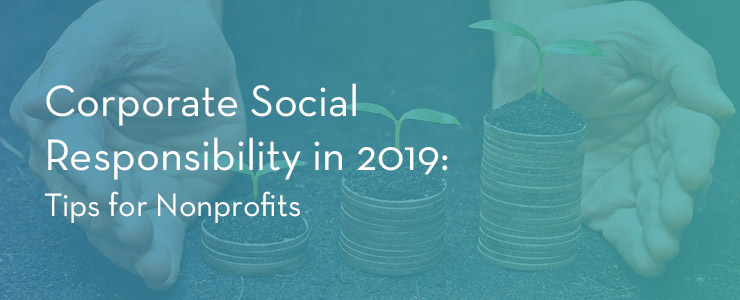Corporate Social Responsibility in 2019: Tips for Nonprofits
This guest post comes from Joshua Meyer, Director of Marketing for OneCause.
Corporate social responsibility, or CSR, is an increasingly important part of how business is done in the 21st century. Digital media (and especially social media) have changed the game faster than anyone could have predicted, largely because it can seriously boost the visibility of individuals, organizations, and companies.

Simply put, CSR is the corporate world’s way to take a more deliberate approach to doing good and demonstrating their values. The main idea is that companies want to contribute to meaningful social projects, boost the digital visibility of these positive actions, and then generate associations between their brand and the charitable projects they participate in.
This is a very good thing for a few reasons:
- Businesses of all sizes are incentivized to take a more active role in shaping their communities for the better.
- Consumers have an increased ability to choose to support brands that they see contributing to the world in positive ways, further incentivizing companies to engage in CSR initiatives.
- Corporate support opens more doors for nonprofits everywhere, making major philanthropic projects more feasible for the largely cash-strapped nonprofit world.
- CSR initiatives help to build more relationships between nonprofits and businesses of all sizes, creating wide-reaching philanthropic networks and support systems.
- These relationships between missions and brands tap into the rise of the social donor, allowing both parties to reach the audiences of the other. Check out our CSR guide for more information on these relationships and the benefits of growing them.
The business world has clearly realized the immense value of investing in philanthropic missions both local and global. According to these matching gift statistics, corporations gave over $20 billion to nonprofits in 2017, an amount that we can expect to see steadily grow with each passing year.
With the benefits of CSR so clear to corporations, nonprofits of all sizes now have more freedom than ever to more deliberately and actively recruit corporate partners. The potential payoff for nonprofits willing to devote time and energy into developing concrete CSR strategies has grown.
If your organization has never partnered with a business for a campaign or event, 2019 is the perfect year to get started. Let’s walk through a few tips for building out your nonprofit’s CSR recruitment strategy.

1. Clearly articulate your goals.
Before developing a plan for growing your corporate support, you need a tangible goal. This best practice holds true for practically any major undertaking, but it’s particularly important when you’re preparing to invest any time, energy, or resources into the project.
Think carefully about what goals you want to establish for your CSR initiative, and be sure to determine a key performance indicator that you can use to measure your progress towards each goal. For example, your organization might want to:
- Successfully complete a specific number of CSR partnerships over the course of the year or another period of time.
- Secure a total of $X through corporate philanthropy programs or partnerships.
- Attract enough corporate support to compose X% of your total annual revenue.
- Raise a total of $X through corporate-sponsored events and campaigns in that year.
Your organization’s particular CSR goals will likely include a combination of goals like the examples above. The main idea is to set a concrete guideline to help structure your initiative as you begin planning specifics like timelines and benchmarks.

2. Do your research on potential partners.
Next, try to focus your efforts on just a handful of potential CSR partners.
If your organization has conducted major donor research in the past in order to solicit a major gift, this process is similar. You wouldn’t blindly ask random donors in your database to make a major gift: you’d risk offending them or simply wasting your own time. You need to make sure you’re approaching the right partners who can help you reach your goals and who stand to benefit from what you can offer, too.
Corporate philanthropy resources are a good place to start your research on companies with proven track records of philanthropic activity. Explore 360MatchPro’s list of top matching gift companies to get a sense of the landscape.

3. Build out a solid campaign proposal.
Your CSR goals most likely revolve around conducting a major campaign and hosting events with the support of a corporate sponsor. If so, take the time to build out a thorough campaign plan early on in the process, before you approach any of the potential partners you’ve already identified.
Having a solid campaign plan that specifically describes the involvement of your potential partner can go a long way to convince them that your nonprofit is a responsible steward of your resources and takes its mission seriously.
For major campaigns, be as thorough as possible. Consider timelines, benchmark metrics, the steps you’ll need to complete before launch, your marketing strategies, and any new tech you’ll need to invest in. This can give a potential partner a more comprehensive sense of your needs and create more flexibility for them to support you in a way that works well for both parties.
For instance, let’s say your organization is ready to make the move to Salesforce and is planning to recruit corporate sponsors for the public phase of an upcoming capital campaign. Outline your technology plans in your comprehensive campaign proposal when you approach sponsors. A potential partner might not want to sponsor a large event, but they might be more interested in helping you invest in the new CRM platform.
Providing potential partners with as much context as possible is always a smart move. For more information, we recommend this webinar with the nonprofit PepUp Tech, whose CSR marketing strategies opened up powerful new revenue streams for their mission.

4. Demonstrate your ability to engage audiences.
Remember, for corporate sponsors, the benefits of taking part in CSR initiatives are largely promotional. Partners need to know that by working together you can get some good work done and be seen by wider audiences.
Consider these strategies for demonstrating your organization’s visibility:
- Invest now in the data tools you need to effectively track and measure donor engagement and the performance of your marketing campaigns.
- Anchor your proposal or goals with a peer-to-peer fundraising campaign. These campaigns are largely powered by social media, and the most successful make use of highly engaging multi-channel marketing strategies. Refresh your team on some peer-to-peer fundraising best practices to see if it might be a good fit for your goals.
- Launch a new social media campaign, even a fairly casual one, to demonstrate your organization’s reach. Create a unique new hashtag, and encourage your community to make posts and share photos with it to raise awareness of your cause.
Taking the time to carefully track your donor engagement should be the foundation of your strategy. Better yet, configure your CRM platform to handle it if you haven’t yet done so. The Salesforce platform is more accessible for nonprofits than ever before, so consider moving to an upgraded CRM platform if your organization is ready for one.
The main idea is to generate engagement data that can prove to your potential CSR partners that your nonprofit’s audience is active and eager to engage with your work.

5. Develop cross-promotional strategies.
The same social and media trends that facilitated the rise of corporate social responsibility as a dominant trend have also made marketing more complex than ever. 2018, in particular, was a pretty volatile year for the digital marketing world.
When developing strategies for attracting more CSR involvement, remember that marketing and visibility are crucial.
Any arrangement beyond a straightforward donation might result in a more complicated exchange of benefits between your organization and a CSR partner, but remember that the primary benefit for any business that supports nonprofit work is positive publicity.
Outline cross-promotional strategies prior to approaching a partner. Or, be sure to ask any interested companies that approach your organization about their own marketing portfolios and plans for promoting your mission to their audiences, fans, employees, other partners, etc.

6. Rely on your organization’s strengths.
This last tip is particularly important because many organizations tend to lose sight of their own particular strengths when they focus on pursuing CSR partnerships and sponsorships. If your nonprofit really excels in one area, make it known to potential sponsors.
For example, does your organization:
- Have an extremely engaged donor base? Do your donors, social media followers, and email subscribers regularly and eagerly engage with your messages? That’s worth communicating to prospective partners who want to ensure their support will be visible. Explore the OneCause guide to ambassador fundraising for ideas on how to maximize the visibility and reach of your campaign.
- Have a relatively young base of support? Many nonprofits struggle to attract younger demographics of donors, so younger donors are often a sign of a particularly unique mission and innovative engagement strategies, all of which a potential sponsor would find very enticing.
- Succeed with a variety of engagement techniques? It can be tricky to find the marketing outlets that your supporters best respond to. If your nonprofit has succeeded in engaging donors with text messages, mobile apps, email campaigns, or any other digital outlets, it’s worth sharing those metrics with potential CSR sponsors.
Corporate Social Responsibility for Nonprofits
The main idea that runs through all of these tips is to take a deliberate, strategic approach to attract potential sponsors or partners via CSR initiatives.
Increased interaction between nonprofits and for-profit companies has made it easier for mission-based organizations to find sponsors eager to support their work, but it’s also given generous companies more opportunities than ever for choosing the perfect partner to align their businesses and brand.
Take an approach similar to how you’d begin planning a major fundraising campaign or conducting prospect research to find a major donor.
The rise of corporate social responsibility represents a major opportunity for nonprofits around the world to expand their reach and more effectively pursue their missions. Remember, CSR takes a wide variety of forms, from large-scale structured sponsorships between giant organizations to small partnerships or simple donations from a local business to a small nonprofit.
Make it a 2019 goal for your organization to start tapping into the opportunities that CSR represents!
Want more tips like this?
Our monthly newsletter is packed with articles like this one from OneCause. Plus, we include stories from fellow nonprofits on exactly how they used Salesforce to achieve their goals.
















